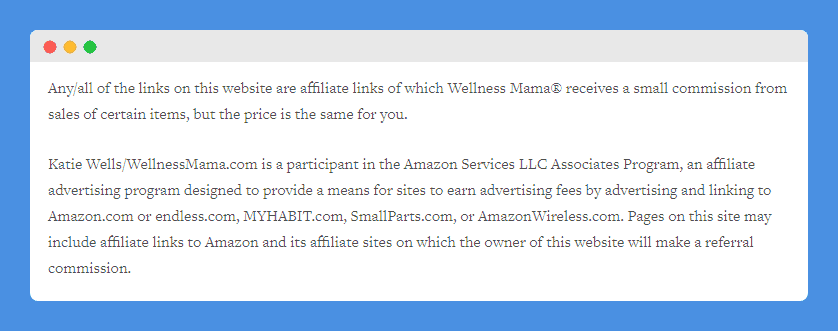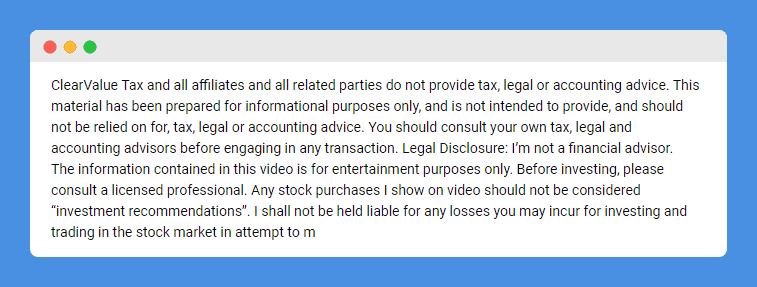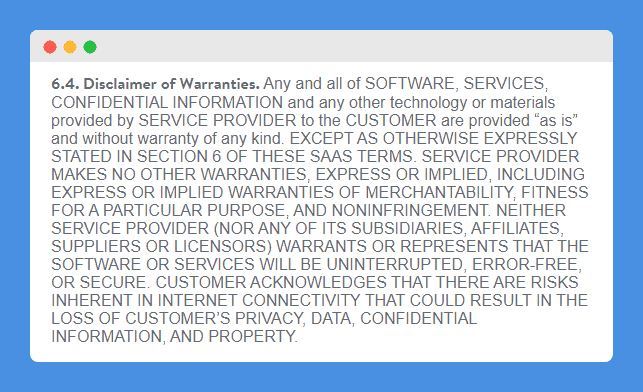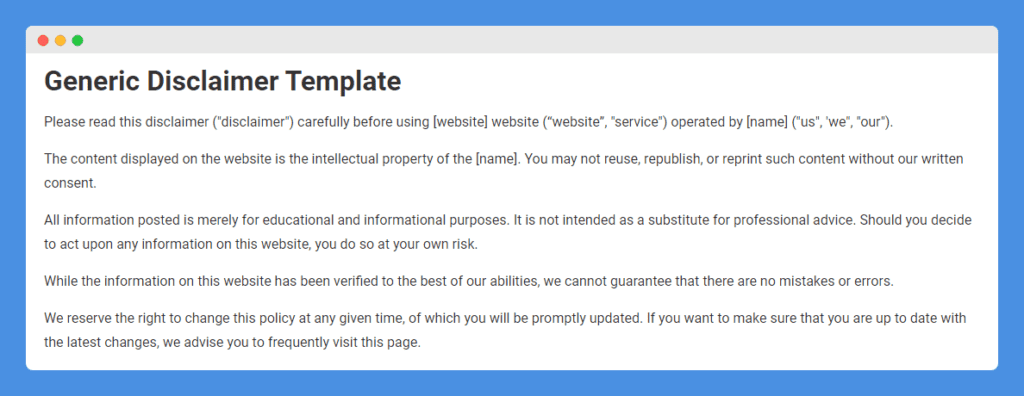If you are visiting this page, you likely want to know how to legally protect yourself and your business from liability risks. To help you do so, we’ve come up with a generic disclaimer template to get you started, as well as some great examples of different types of commonly used disclaimers.
Table of Contents
PRO TIP: Take the hassle of writing your own disclaimer away with our disclaimer generator trusted by over 200,000 businesses. It’ll save you hours of work and possible costly legal mistakes.
Sample Disclaimer Template
A disclaimer is a notice that appears on a blog, website, document, or product to provide a warning to your users and to limit your liability when it comes to specific aspects of your business.
This generic disclaimer template will help you understand how to form a legal agreement. Keep in mind that this is just an example disclaimer template and does not cover many of the important topics.
Disclaimer Examples
Here are 15 disclaimer examples from different industries and website types to give give you a better idea of what kind of clauses your own disclaimer has to include.
Fair Use Disclaimer
The law has made it acceptable, under very specific circumstances and for very specific purposes only, for one to use someone else’s copyrighted work without first requiring their consent.
The following purposes are explicitly considered to be “fair use” under Title 17, Section 107 of the United States Code and thus should not be considered copyright infringement:
- Criticism
- Comment
- News reporting
- Teaching
- Scholarship
- Research
Fair use is not limited to the above and is to be considered on a case-by-case basis.
Here is an example of a fair use disclaimer from CUInsight, a website for the credit union community, that notably has a news section and a blog:

CUInsight’s website fair use policy specifies that the copyrighted material made available is in the effort of advancing the understanding of the credit union industry and issues.
If you are summarizing or quoting someone else’s work, including a fair use disclaimer on your website could protect you from being accused of copyright infringement, as you are recognizing and informing your readers that the text quoted is not your own words and that you consider said use to be fair.
Copyright Disclaimer Notice
Conversely, a copyright disclaimer is used to protect the ownership of your work; you would include it on your website to warn users that the content materials are your property and should not be reproduced without your authorization.
Your copyright notice doesn’t have to be very long, as long as it contains:
- The copyright symbol
- The name of your company/owner of the copyrighted work
- The year of publication
- The mention “All Rights Reserved” or “Some Rights Reserved”, depending on which rights you wish to retain
For example, here is a screenshot of Hootsuite’s copyright disclaimer notice:

This is the simple copyright statement that appears on the social media management platform Hootsuite’s homepage.
While having such a disclaimer is generally not essential for your work to be protected by copyright, it is an easy step to take to put everyone on notice that the content of your website is proprietary and should not be used without your permission.
Affiliate Disclaimer
It is essential that you let your website visitors know that you may receive financial compensation if they choose to use one of your affiliate links; it is actually legally required by the Federal Trade Commission (FTC) in the United States.
An affiliate disclosure statement should clearly indicate the nature of your relationship with the brand/product that you are promoting or endorsing and it should stand out to your readers.
Here is a short but easy-to-understand affiliate disclaimer example from a DigitalMarketer blog post:

DigitalMarketer’s affiliate disclosure statement appears at the top of their blog post, which recommends must-read books for marketers.
And here is a longer sample affiliate disclaimer from popular blog WellnessMama, which appears on a dedicated page on the website and specifically mentions the FTC and Amazon:

In addition to the above statement, WellnessMama also discloses her affiliate relationship in each one of her blog posts.
In addition to the above, you should always check the requirements of the affiliate program that you are working with as some, such as the Amazon Associates program, have stricter requirements and preferred wording that should be used by their affiliates.
Financial and Investment Disclaimer
If you are sharing any kind of financial information on your website, you should consider having a financial and investment disclaimer.
Indeed, this will warn your website visitors that you cannot be held liable for the financial or investment decisions that they make as a result of consuming your content. It also warns them that the information that you are sharing does not constitute financial advice and is for educational or informational purposes only.
Here is an example from advisory firm Harrington Investments, Inc.:

This “no investment advice” disclaimer specifies that the content provided on Harrington Investment’s website does not constitute financial or professional advice.
And from cryptocurrency tracking tool CoinMarketCap:

CoinMarketCap’s disclaimer addresses the accuracy of the information provided and encourages website users to do their own research before making any investment decisions.
Considering the volatility of the stock market and the financial industry as a whole, this type of disclaimer is a must to avoid being held liable should one of your website users make poor investment decisions based on an article that they read on your blog.
Health and Medical Disclaimer
Similar to the financial and investment disclaimer above, a health and medical disclaimer is used to warn your readers that the information provided on your website is not to be taken as professional medical advice and is for educational purposes only.
With most of us now looking up our symptoms online before seeking medical advice, having such a disclaimer should be standard on any website sharing medical information. After all, even if the information provided is correct, it cannot replace a doctor as every person has a unique health history that should be taken into account.
Online publishers of medical information, such as the ever-popular WebMD, have them, as do hospitals that have an online presence such as St. Joseph’s Healthcare Hamilton:
St. Joseph’s Healthcare Hamilton’s disclaimer specifies that the information provided does not create a doctor-patient relationship.
This also goes for anyone offering health-related advice, such as fitness or lifestyle professionals. Motivational speaker Tony Robbins has a health disclaimer on his website:

Tony Robbins shares information regarding mental health, such as how to deal with anxiety and depression, on his website, which is why it is wise for him to have such a disclaimer.
And MelissaWoodHealth, who offers online pilates training through her website, includes the following fitness disclaimer:

MelissaWoodHealth’s disclaimer encourages users to seek professional advice before starting a new fitness program and emphasizes that by doing her workouts, you are doing so at your own risk.
Legal Disclaimer
Any website sharing legal-related news, content, or advice should have a legal disclaimer in place that specifies that the information provided is for informational purposes only and does not create a lawyer-client relationship.
Here is a sample legal disclaimer from Dentons, one of the world’s largest law firms:

This is part of Denton’s terms of use, which also include various other disclaimers and limitations of liability.
Video and YouTube Disclaimer
A YouTube channel, like a blog, is a great way for a business to share information with potential customers. However, the fact that it’s in video format doesn’t protect you from a lawsuit: you still need to include the proper disclaimers in your videos and on your channel as your words do carry weight.
You need to assume that people could act upon the information contained in your videos so, depending on what you are sharing with your viewers, you may want to add one of the following disclaimers (this list is non-exhaustive, these are just common examples):
- Use at your own risk
- Affiliate disclosure
- Professional liability (medical, legal, health and fitness)
- No responsibility disclaimer
- Copyright disclaimer
You could include these disclaimers in the first few seconds of your video or in its description.
Here is a screenshot from ClearValue Tax Preparation’s YouTube Channel – their accountant, Brian Kim, is particularly active on the platform and their channel now has over 815K subscribers:

This is the disclaimer that appears on their YouTube channel’s “About” page, which they also include in part in each one of their video descriptions.
Views Expressed Disclaimer
A “views expressed” disclaimer is used to notify your readers that the views expressed on your website are yours, and yours only, and not those of any employer or organization that you are affiliated to.
This type of disclaimer is also frequently used on social media, especially on LinkedIn, when an employee wants to make it clear that the comments that they make or the posts that they share are not endorsed by their employer, even though it may be on a topic that is related to their professional field of expertise.
Here is a “views expressed” disclaimer from the American Bar Association (ABA), as multiple lawyers and members contribute to their website content:

This “views expressed” disclaimer on the ABA’s website makes it clear that the lawyers that contribute to the platform do so in their individual capacity, and not as employees of the law firms that employ them.
Having such a disclaimer is also essential if you own a website on which readers or other third parties share their opinions on a subject or review products.
For example, here is a “views expressed” disclaimer for user-generated content that can be found in The Guardian’s terms of service:

The Guardian’s terms and conditions of use make it clear that they do not necessarily endorse the views and opinions expressed by its readers.
While this does not make it acceptable to write just anything online, at least your opinions will not be wrongly attributed to someone else, which could have devastating consequences.
No Responsibility Disclaimer
A “no responsibility” disclaimer (also known as a “liability disclaimer”) serves to protect your business from being held liable or responsible for damages that could arise from someone consuming content on your website or following links to third-party websites that you share.
Here is an example of a disclaimer of liability from Nanyang Technical University in Singapore:

Nanyang Technical University’s liability disclaimer addresses content on their website as well as to websites that they link to.
No Guarantee Disclaimer
A no guarantee disclaimer serves to warn your website visitors that, while you are doing your best to ensure the accuracy of the content that you publish, you cannot provide a guarantee for it and, thus, cannot be held responsible for incorrect information and the consequences that could arise from acting upon it.
By way of example, here is a no guarantee disclaimer that appears on the Tennessee Department of Environment and Conservation website:

While the department makes this list available to its constituents to make financial assurance requirements more intelligible, it does not guarantee the validity of the information.
This type of disclaimer can often be found on websites owned by an organization or people who share their expertise or knowledge on a specific subject, especially if the topic is complex or ever-evolving.
Trademark Disclaimer
A trademark disclaimer should be displayed on your website if you are using another company’s registered trademark. This could be the case if you are talking about a brand in a blog post and include their trademarked logo, for example. Or if you are selling products from various brands and include their company logo on the product description page.
Native Instruments, a leader in digital music production, display the following disclaimer on its website:

This disclaimer is followed by a list of all the registered trademarks used on their website as well as the names of the companies that own them, which clears up any confusion for their users.
By including a trademark disclaimer, you will be making it clear to your website visitors that you are referring to a registered trademark that is not yours, which could help protect you against a trademark infringement complaint.
Confidentiality Disclaimer
Confidentiality disclaimers often appear in the footer of an email, after the signature block. They are used by most companies that exchange sensitive or confidential information over email with the goal of limiting their liability should the email end up in the wrong hands.
Here is a very detailed email disclaimer used by Sevocomm, a global telecommunication company,

This confidentiality disclaimer by Sevocomm is displayed on their website; one can imagine that the disclaimer in their employees’ email signatures is a condensed version of the above.
Confidentiality disclaimers can be general or more specific, depending on the nature of your business.
Past Performance Disclaimer
Past performance disclaimers are notably used by financial institutions, investment firms, and trading platforms to warn potential and current clients that past performance does not guarantee any future results: this is due to the volatile nature of the financial markets.
It serves to protect them from lawsuits brought on by disappointed clients that were expecting a good return on investment or specific results.
Here is the past performance disclaimer that appears on Wealthsimple’s website:

Wealthsimple’s past performance disclaimer refers to its investment risk disclosure, which summarizes the risks of investing in various financial products.
Zero commission stock-trading platform Robinhood includes this text in their website footer:

This past performance disclaimer addresses the risk inherent to investing in securities and encourages investors to think about their objectives before getting started.
Testimonial Disclaimer
Having raving customer reviews and testimonials on your website or social media profiles can be a great way to attract new business however, you must ensure that you have the proper disclaimer.
IdealShape is a company that sells meal replacement shakes, bars, and supplements that promote weight loss; it uses testimonials and success stories on its websites to promote its products. Here is its testimonial disclaimer:

IdealShape’s testimonial disclaimer mentions that some people may have received compensation in exchange for their testimonials, in the form of free products or discounts.
A testimonial disclaimer is essential if you want to comply with applicable laws. It should mention that your previous customers’ experience does not guarantee that any future user will have the same results and, if the individual received any kind of compensation for the review, it should be clearly disclosed.
“As Is” and No Warranty Disclaimer
Frequently included in website terms and conditions, an “as is” or no warranty disclaimer warns users that by choosing to use your website, software, or product, they are assuming the inherent risks. It also underlines that you are not making any guarantees other than what is expressly provided for.
Kayako is a customer service and help desk software provider. Here is the disclaimer of warranties that is part of their terms and conditions:

Kayako’s disclaimer of warranties specifically mentions the risks inherent to Internet connectivity, which could potentially have consequences for which they disclaim liability.
Twitter’s terms of service also include an “as-is” disclaimer:

Twitter’s no warranty disclaimer is detailed and specifically mentions the situations or events in which they disclaim liability.
Your no warranty disclaimer should be hard to miss for your users, as they have to be made aware that such a clause exists before choosing to do business with you or use your software or website.
How do I Write a Disclaimer?
A disclaimer is an important piece of the puzzle when you are assembling a website. Will a good disclaimer completely protect you against any possible legal action? No, there is nothing you can do to prevent possible legal action.
However, a valid disclaimer is a great way to protect yourself against many different claims of liability. As long as your disclaimer is well-written and relevant to your site, it will play an important role in the legal side of your business.
Simply copying and pasting a disclaimer from another website is not a good idea, you need to have one that is tailored to the needs and requirements of your business.
Use our online generator to come up with an attorney-drafted disclaimer based on your specific needs and requirements. It’s fast, simple, and reliable.




